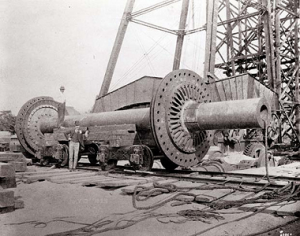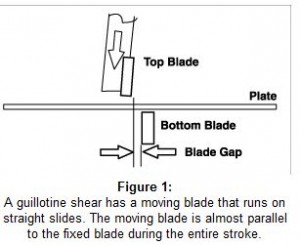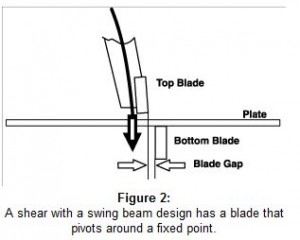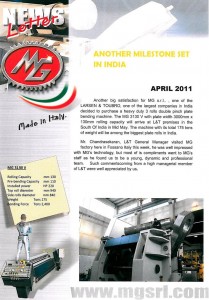The ISM Manufacturing Purchasing Managers Index was broadly covered in the media, which most sources mentioning manufacturing’s key role in helping the US regain its economic footing. It was also noted that April’s expansion marked a slight decline from March, due in part to higher input costs, but that overall the results, and the outlook for the sector, are very good. The impact of a weak dollar was also noted.
The AP (5/3) reports, “The nation’s manufacturing sector has expanded this year at the fastest pace in a quarter-century, boosted by a weak dollar that has made US goods cheap overseas.” The strong manufacturing sector “could help the economy rebound after experiencing weak growth in the first three months of this year,” although other industries such as construction are still struggling, and raw materials prices remain a concern. “The Institute for Supply Management said Monday that manufacturing activity expanded in April for the 21st straight month.” Although the reading of 60.4 represents a decline from 61.2 in March, it still indicates manufacturing growth..
Bloomberg News (5/3, Willis) reports “manufacturing expanded faster than forecast in April, driven by gains in exports and inventories that are keeping the industry at the forefront of the US economic expansion.” And these same factors, “demand from emerging economies like China” and “the need to replenish stockpiles and investment in new equipment, may keep benefitting manufacturers.” Bloomberg notes that “another report showed construction spending rose more than forecast in March as companies put up factories and power plants, while home improvement outlays also rebounded.”
New York Times /Reuters (5/3, B8) reports that, according to the Commerce Department report on construction, March spending was up 1.4 percent, an entire point higher than analysts had predicted on average. However, Reuters noted, the sector remained anemic overall, having a long way to go before it can offset the declines it saw last year.
AFP (5/3) characterizes the manufacturing news in opposite terms, noting the expansion but highlighting the slowing pace of “growth in new orders, production, employment and supplier deliveries.” Norbert Ore, head of the ISM’s manufacturing committee, is quoted as saying, “While the manufacturing sector is definitely performing above most expectations so far in 2011, manufacturers are experiencing significant cost pressures from commodities and other inputs.” Daniel J. Meckstroth, Chief Economist for the Manufacturers Alliance/MAPI, however, said manufacturing was “booming.” He added, “It is clear from today’s report that the few things holding back domestic manufacturers are skyrocketing commodity prices, selective commodity shortages, sluggish residential construction and declining non-residential construction.”
Under the headline “Materials Costs Hit Factories’ Activity,” the Wall Street Journal (5/3, Murray, Hagerty, Subscription Publication) notes the same factors as AFP as impediments to growth, but adds that manufacturing continued to expand regardless, albeit at a slightly slower pace. Exports are playing a major role in many cases, such as Caterpillar, which recently reported that it was having difficulty meeting demand for some of its earthmoving equipment. That demand originates in developing economies in Asia and Latin America.
The Financial Times (5/3, Bond, Subscription Publication) notes that, of the 18 industries tracked by the ISM, only one showed signs of contracting – furniture and furniture-related products. The other 17 industries all showed expansion to different degrees.
The Chicago Tribune (5/3) reports, “The pace of expansion in US manufacturing slowed in April for a second straight month but was brisker than expected, data showed on Monday, a sign the sector was holding up despite slower national growth.” Kurt Karl, chief US economist at Swiss Re, said: “With what is happening in the world at this point, you would expect (manufacturing numbers) to be down.” He added, “We’ve had (higher) oil prices, we have had hits to Japan, we have had hits domestically from production and supply constraints from the Japanese disruptions and we are still over 60 on the manufacturing (index). So it is a very good report.” The Tribune also notes the Commerce Department report, and calls the increase in construction spending “encouraging.” CBC News (5/3) and Marketwatch (5/3 Bartash) also report the story.
From SME Daily Executive Briefing 5/3/2011

 Once again this week, I threw myself wholeheartedly into a Google search for the largest metal object in the world, if only because I know that my scores of avid followers on this blog have all been holding their breath since I brought this subject up in last week’s blog entry. And once again this week, I got completely sidetracked. You would have too, after scanning the Google results for “large metal object”.
Once again this week, I threw myself wholeheartedly into a Google search for the largest metal object in the world, if only because I know that my scores of avid followers on this blog have all been holding their breath since I brought this subject up in last week’s blog entry. And once again this week, I got completely sidetracked. You would have too, after scanning the Google results for “large metal object”. I’ve been curious for some time to find out what the largest metal object in the world is. By “largest metal object in the world”, I mean an object that is formed out of solid metal and is one contiguous piece of homogeneous metal. In other words, search results that yielded things like “largest metal sculpture in the world” don’t count, in my opinion. Additionally, I was looking for something that served an actual purpose, not just something to look at.
I’ve been curious for some time to find out what the largest metal object in the world is. By “largest metal object in the world”, I mean an object that is formed out of solid metal and is one contiguous piece of homogeneous metal. In other words, search results that yielded things like “largest metal sculpture in the world” don’t count, in my opinion. Additionally, I was looking for something that served an actual purpose, not just something to look at.

 I’ve recently been spending a disproportionate amount of my time working on a boat. By boat, I mean a 39-ft sail boat (or cruiser, if you prefer) that we are planning to sail to the Caribbean in a few weeks. Anyone who’s owned or worked with boats will tell you that the amount of work that goes into the maintenance and upkeep of one cannot possibly be exaggerated. Re-sanding and re-varnishing the entire interior is just the icing on the cake. The electrical needs rewiring in places, the plumbing needs an overhaul, the hull needs to be scraped and repainted, the windows need to be painted and installed, and the list just keeps going on from there. In fact, it’s kind of depressing just writing about it, considering that our plan is to leave at the end of the month.
I’ve recently been spending a disproportionate amount of my time working on a boat. By boat, I mean a 39-ft sail boat (or cruiser, if you prefer) that we are planning to sail to the Caribbean in a few weeks. Anyone who’s owned or worked with boats will tell you that the amount of work that goes into the maintenance and upkeep of one cannot possibly be exaggerated. Re-sanding and re-varnishing the entire interior is just the icing on the cake. The electrical needs rewiring in places, the plumbing needs an overhaul, the hull needs to be scraped and repainted, the windows need to be painted and installed, and the list just keeps going on from there. In fact, it’s kind of depressing just writing about it, considering that our plan is to leave at the end of the month.